child seat JEEP PATRIOT 2007 1.G Owners Manual
[x] Cancel search | Manufacturer: JEEP, Model Year: 2007, Model line: PATRIOT, Model: JEEP PATRIOT 2007 1.GPages: 440, PDF Size: 7.26 MB
Page 11 of 440
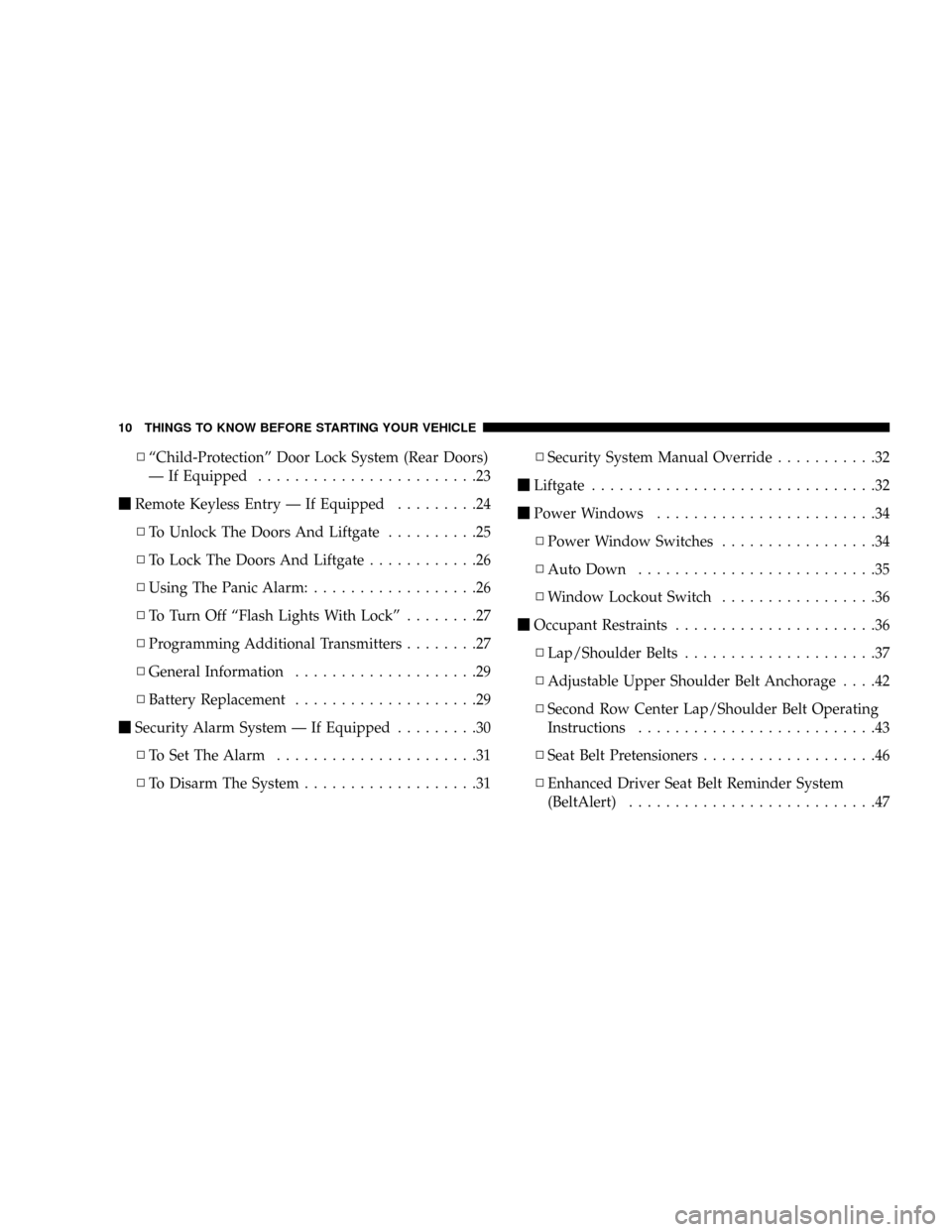
NªChild-Protectionº Door Lock System (Rear Doors)
Ð If Equipped........................23
mRemote Keyless Entry Ð If Equipped.........24
NTo Unlock The Doors And Liftgate..........25
NTo Lock The Doors And Liftgate............26
NUsing The Panic Alarm:..................26
NTo Turn Off ªFlash Lights With Lockº........27
NProgramming Additional Transmitters........27
NGeneral Information....................29
NBattery Replacement....................29
mSecurity Alarm System Ð If Equipped.........30
NTo Set The Alarm......................31
NTo Disarm The System...................31NSecurity System Manual Override...........32
mLiftgate...............................32
mPower Windows........................34
NPower Window Switches.................34
NAuto Down..........................35
NWindow Lockout Switch.................36
mOccupant Restraints......................36
NLap/Shoulder Belts.....................37
NAdjustable Upper Shoulder Belt Anchorage....42
NSecond Row Center Lap/Shoulder Belt Operating
Instructions..........................43
NSeat Belt Pretensioners...................46
NEnhanced Driver Seat Belt Reminder System
(BeltAlert)...........................47
10 THINGS TO KNOW BEFORE STARTING YOUR VEHICLE
Page 12 of 440
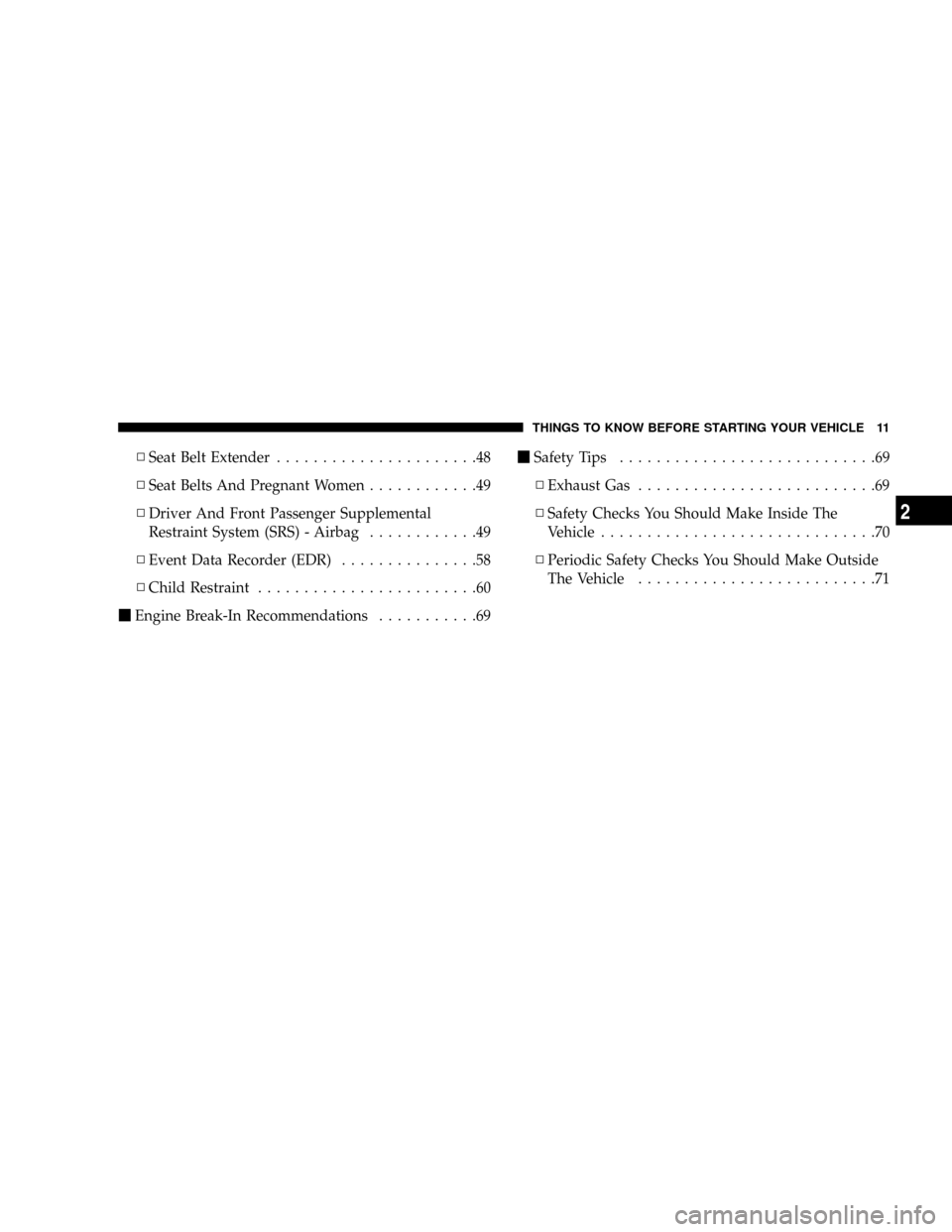
NSeat Belt Extender......................48
NSeat Belts And Pregnant Women............49
NDriver And Front Passenger Supplemental
Restraint System (SRS) - Airbag............49
NEvent Data Recorder (EDR)...............58
NChild Restraint........................60
mEngine Break-In Recommendations...........69mSafety Tips............................69
NExhaust Gas..........................69
NSafety Checks You Should Make Inside The
Vehicle..............................70
NPeriodic Safety Checks You Should Make Outside
The Vehicle..........................71
THINGS TO KNOW BEFORE STARTING YOUR VEHICLE 11
2
Page 37 of 440
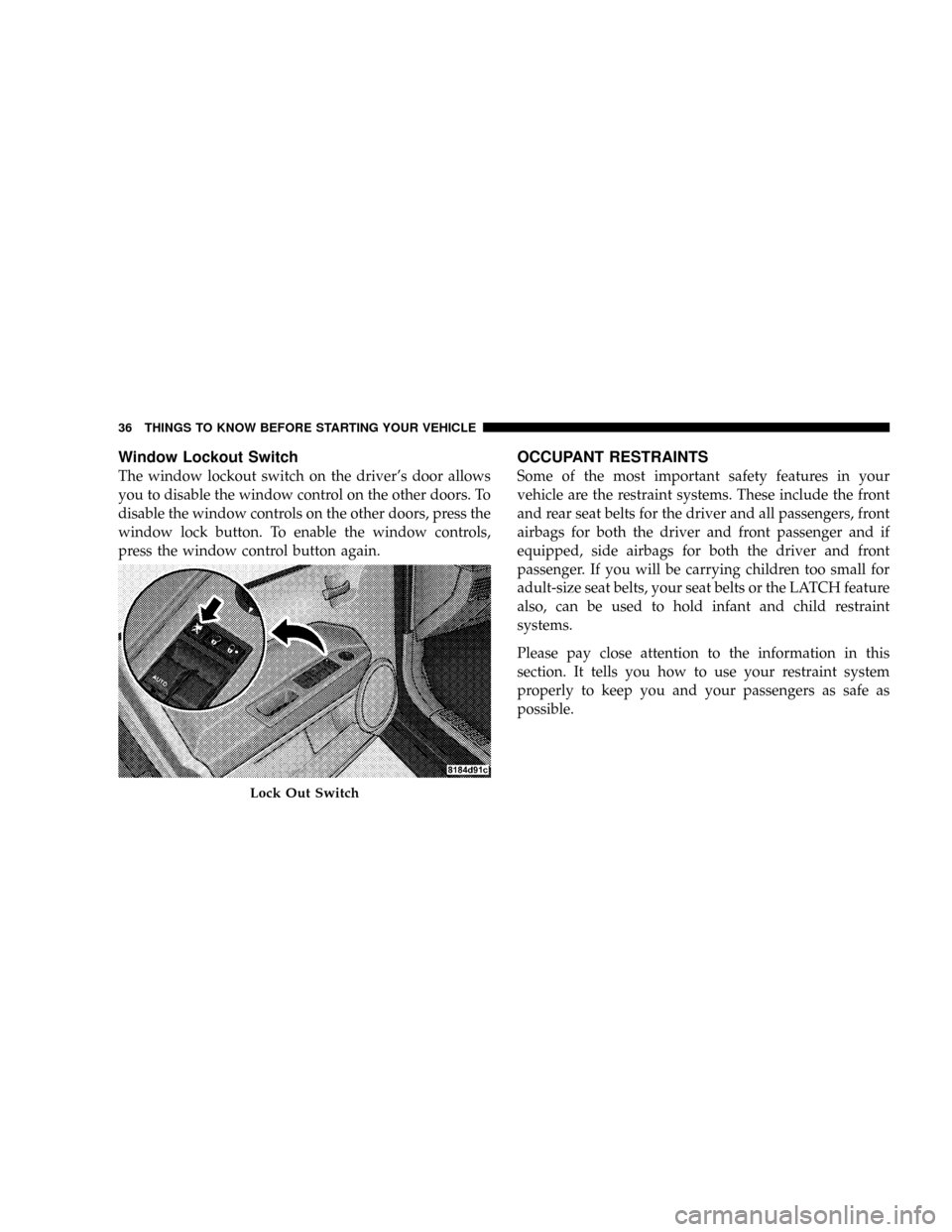
Window Lockout Switch
The window lockout switch on the driver's door allows
you to disable the window control on the other doors. To
disable the window controls on the other doors, press the
window lock button. To enable the window controls,
press the window control button again.
OCCUPANT RESTRAINTS
Some of the most important safety features in your
vehicle are the restraint systems. These include the front
and rear seat belts for the driver and all passengers, front
airbags for both the driver and front passenger and if
equipped, side airbags for both the driver and front
passenger. If you will be carrying children too small for
adult-size seat belts, your seat belts or the LATCH feature
also, can be used to hold infant and child restraint
systems.
Please pay close attention to the information in this
section. It tells you how to use your restraint system
properly to keep you and your passengers as safe as
possible.
Lock Out Switch
36 THINGS TO KNOW BEFORE STARTING YOUR VEHICLE
Page 47 of 440
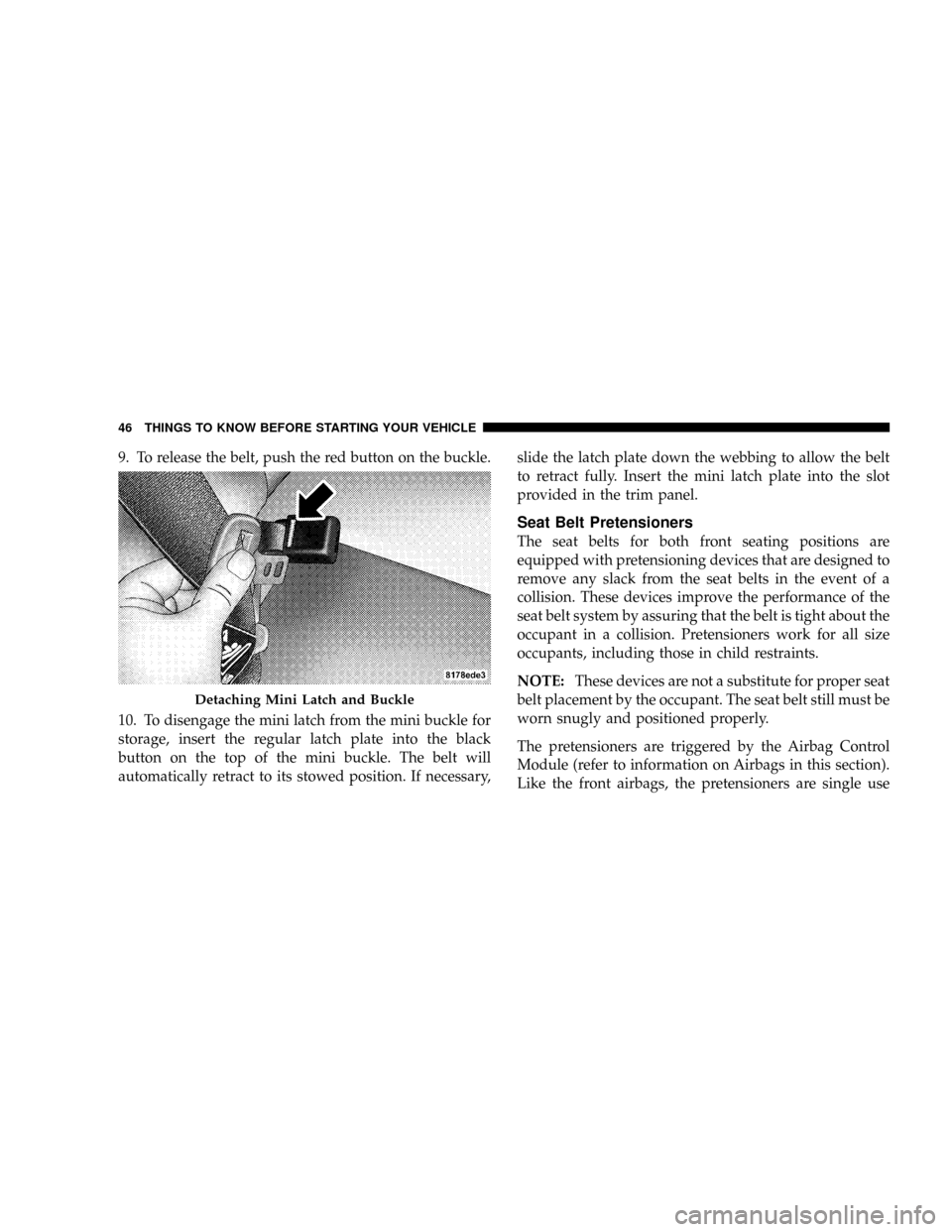
9. To release the belt, push the red button on the buckle.
10. To disengage the mini latch from the mini buckle for
storage, insert the regular latch plate into the black
button on the top of the mini buckle. The belt will
automatically retract to its stowed position. If necessary,slide the latch plate down the webbing to allow the belt
to retract fully. Insert the mini latch plate into the slot
provided in the trim panel.
Seat Belt Pretensioners
The seat belts for both front seating positions are
equipped with pretensioning devices that are designed to
remove any slack from the seat belts in the event of a
collision. These devices improve the performance of the
seat belt system by assuring that the belt is tight about the
occupant in a collision. Pretensioners work for all size
occupants, including those in child restraints.
NOTE:These devices are not a substitute for proper seat
belt placement by the occupant. The seat belt still must be
worn snugly and positioned properly.
The pretensioners are triggered by the Airbag Control
Module (refer to information on Airbags in this section).
Like the front airbags, the pretensioners are single use
Detaching Mini Latch and Buckle
46 THINGS TO KNOW BEFORE STARTING YOUR VEHICLE
Page 53 of 440
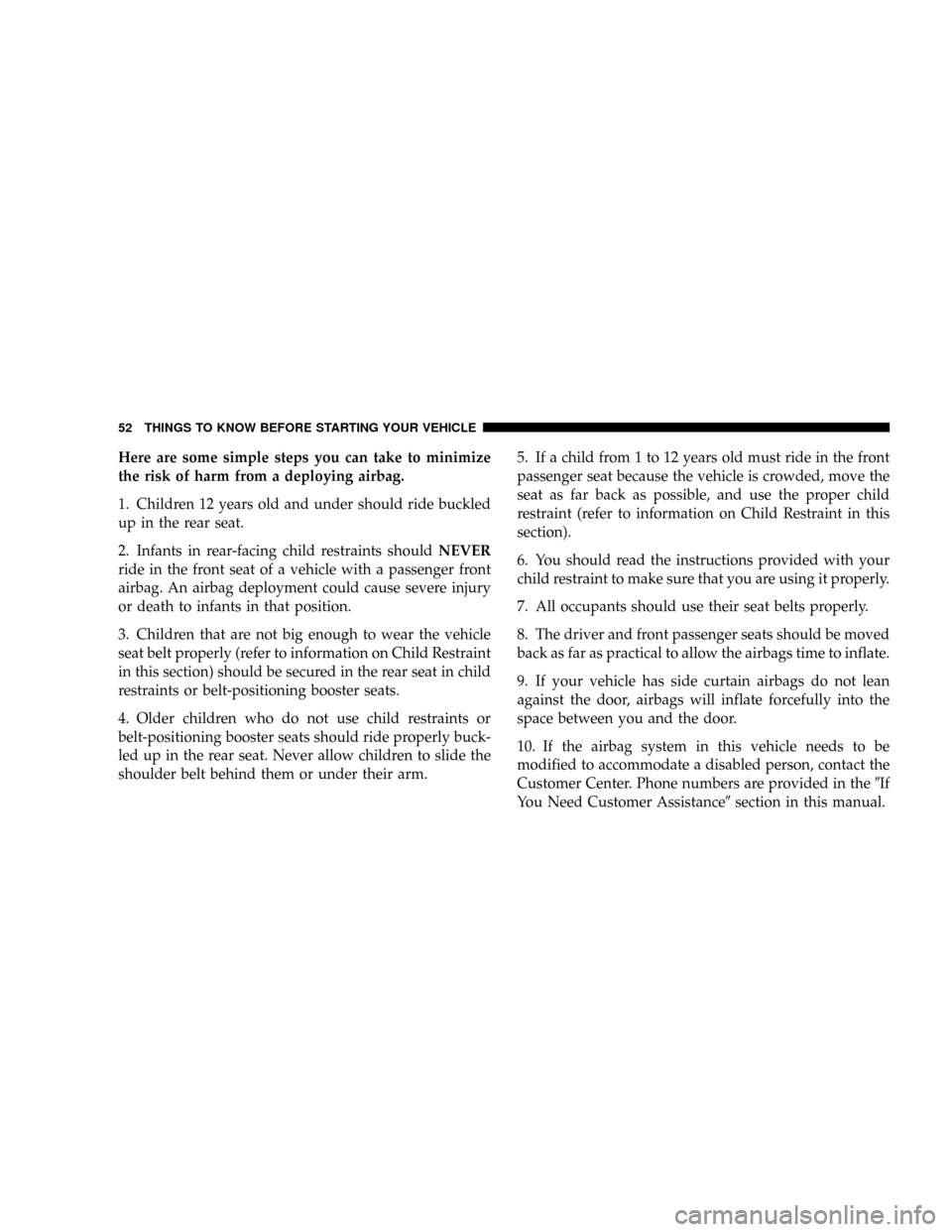
Here are some simple steps you can take to minimize
the risk of harm from a deploying airbag.
1. Children 12 years old and under should ride buckled
up in the rear seat.
2. Infants in rear-facing child restraints shouldNEVER
ride in the front seat of a vehicle with a passenger front
airbag. An airbag deployment could cause severe injury
or death to infants in that position.
3. Children that are not big enough to wear the vehicle
seat belt properly (refer to information on Child Restraint
in this section) should be secured in the rear seat in child
restraints or belt-positioning booster seats.
4. Older children who do not use child restraints or
belt-positioning booster seats should ride properly buck-
led up in the rear seat. Never allow children to slide the
shoulder belt behind them or under their arm.5. If a child from 1 to 12 years old must ride in the front
passenger seat because the vehicle is crowded, move the
seat as far back as possible, and use the proper child
restraint (refer to information on Child Restraint in this
section).
6. You should read the instructions provided with your
child restraint to make sure that you are using it properly.
7. All occupants should use their seat belts properly.
8. The driver and front passenger seats should be moved
back as far as practical to allow the airbags time to inflate.
9. If your vehicle has side curtain airbags do not lean
against the door, airbags will inflate forcefully into the
space between you and the door.
10. If the airbag system in this vehicle needs to be
modified to accommodate a disabled person, contact the
Customer Center. Phone numbers are provided in the9If
You Need Customer Assistance9section in this manual.
52 THINGS TO KNOW BEFORE STARTING YOUR VEHICLE
Page 56 of 440
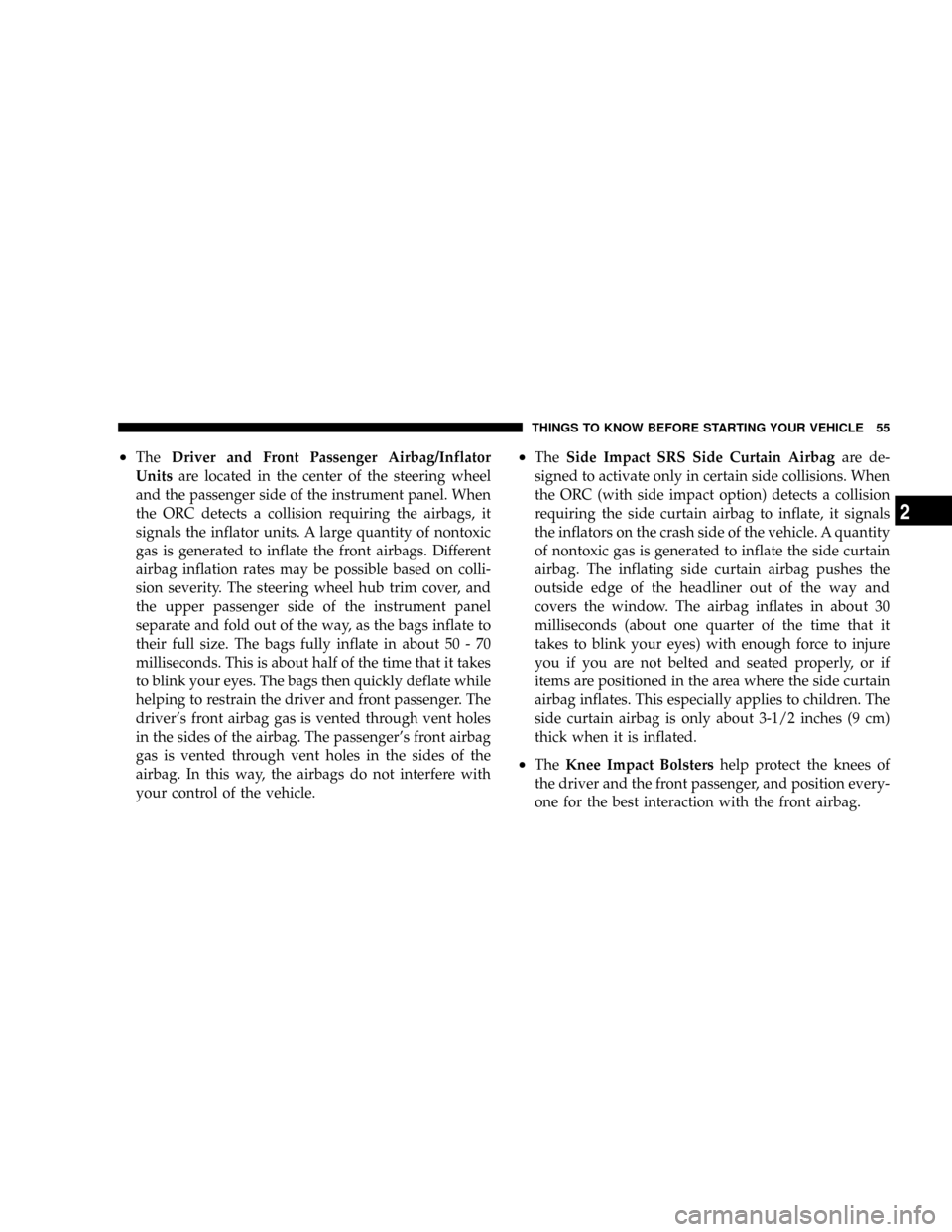
²TheDriver and Front Passenger Airbag/Inflator
Unitsare located in the center of the steering wheel
and the passenger side of the instrument panel. When
the ORC detects a collision requiring the airbags, it
signals the inflator units. A large quantity of nontoxic
gas is generated to inflate the front airbags. Different
airbag inflation rates may be possible based on colli-
sion severity. The steering wheel hub trim cover, and
the upper passenger side of the instrument panel
separate and fold out of the way, as the bags inflate to
their full size. The bags fully inflate in about 50 - 70
milliseconds. This is about half of the time that it takes
to blink your eyes. The bags then quickly deflate while
helping to restrain the driver and front passenger. The
driver's front airbag gas is vented through vent holes
in the sides of the airbag. The passenger's front airbag
gas is vented through vent holes in the sides of the
airbag. In this way, the airbags do not interfere with
your control of the vehicle.²TheSide Impact SRS Side Curtain Airbagare de-
signed to activate only in certain side collisions. When
the ORC (with side impact option) detects a collision
requiring the side curtain airbag to inflate, it signals
the inflators on the crash side of the vehicle. A quantity
of nontoxic gas is generated to inflate the side curtain
airbag. The inflating side curtain airbag pushes the
outside edge of the headliner out of the way and
covers the window. The airbag inflates in about 30
milliseconds (about one quarter of the time that it
takes to blink your eyes) with enough force to injure
you if you are not belted and seated properly, or if
items are positioned in the area where the side curtain
airbag inflates. This especially applies to children. The
side curtain airbag is only about 3-1/2 inches (9 cm)
thick when it is inflated.
²TheKnee Impact Bolstershelp protect the knees of
the driver and the front passenger, and position every-
one for the best interaction with the front airbag.
THINGS TO KNOW BEFORE STARTING YOUR VEHICLE 55
2
Page 61 of 440
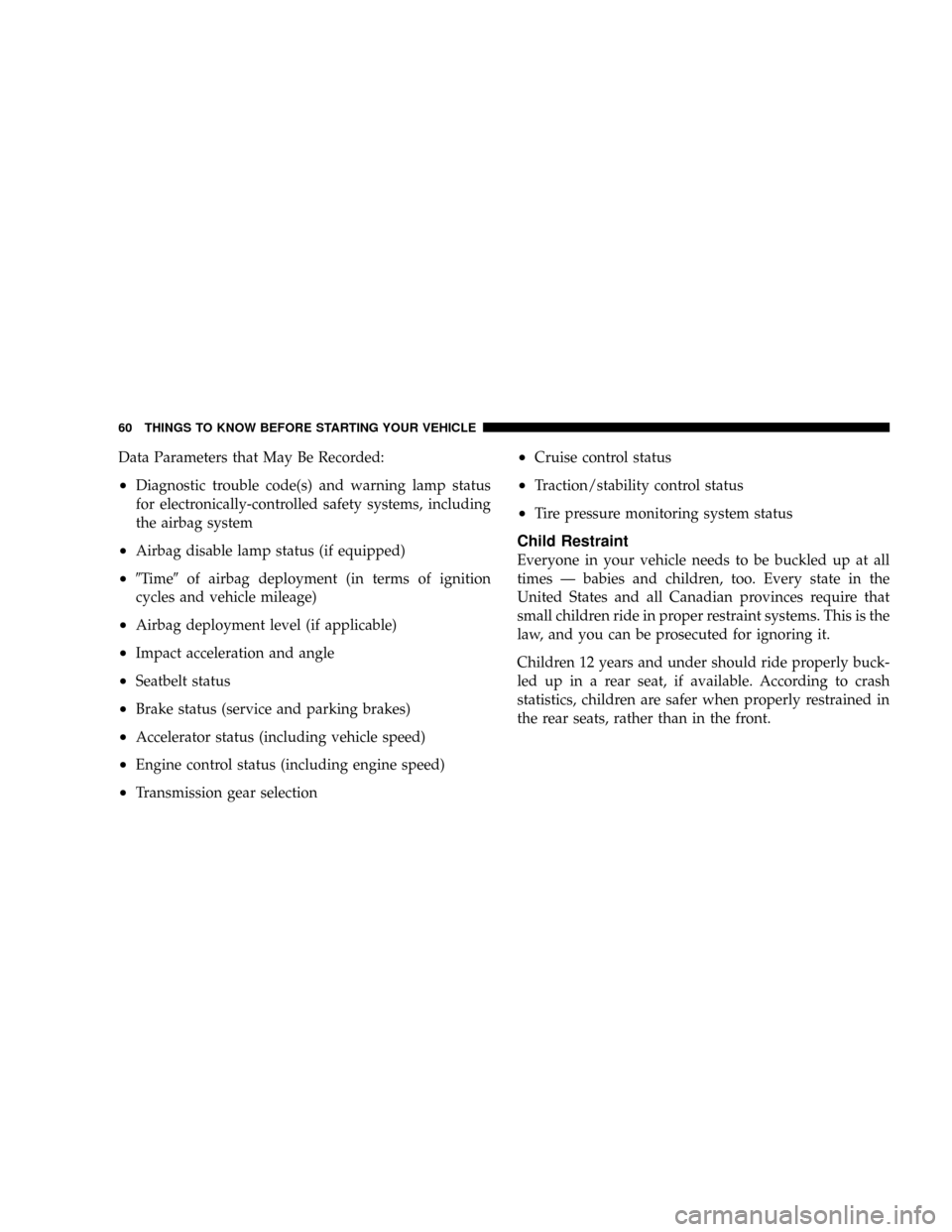
Data Parameters that May Be Recorded:
²Diagnostic trouble code(s) and warning lamp status
for electronically-controlled safety systems, including
the airbag system
²Airbag disable lamp status (if equipped)
²9Time9of airbag deployment (in terms of ignition
cycles and vehicle mileage)
²Airbag deployment level (if applicable)
²Impact acceleration and angle
²Seatbelt status
²Brake status (service and parking brakes)
²Accelerator status (including vehicle speed)
²Engine control status (including engine speed)
²Transmission gear selection
²Cruise control status
²Traction/stability control status
²Tire pressure monitoring system status
Child Restraint
Everyone in your vehicle needs to be buckled up at all
times Ð babies and children, too. Every state in the
United States and all Canadian provinces require that
small children ride in proper restraint systems. This is the
law, and you can be prosecuted for ignoring it.
Children 12 years and under should ride properly buck-
led up in a rear seat, if available. According to crash
statistics, children are safer when properly restrained in
the rear seats, rather than in the front.
60 THINGS TO KNOW BEFORE STARTING YOUR VEHICLE
Page 62 of 440
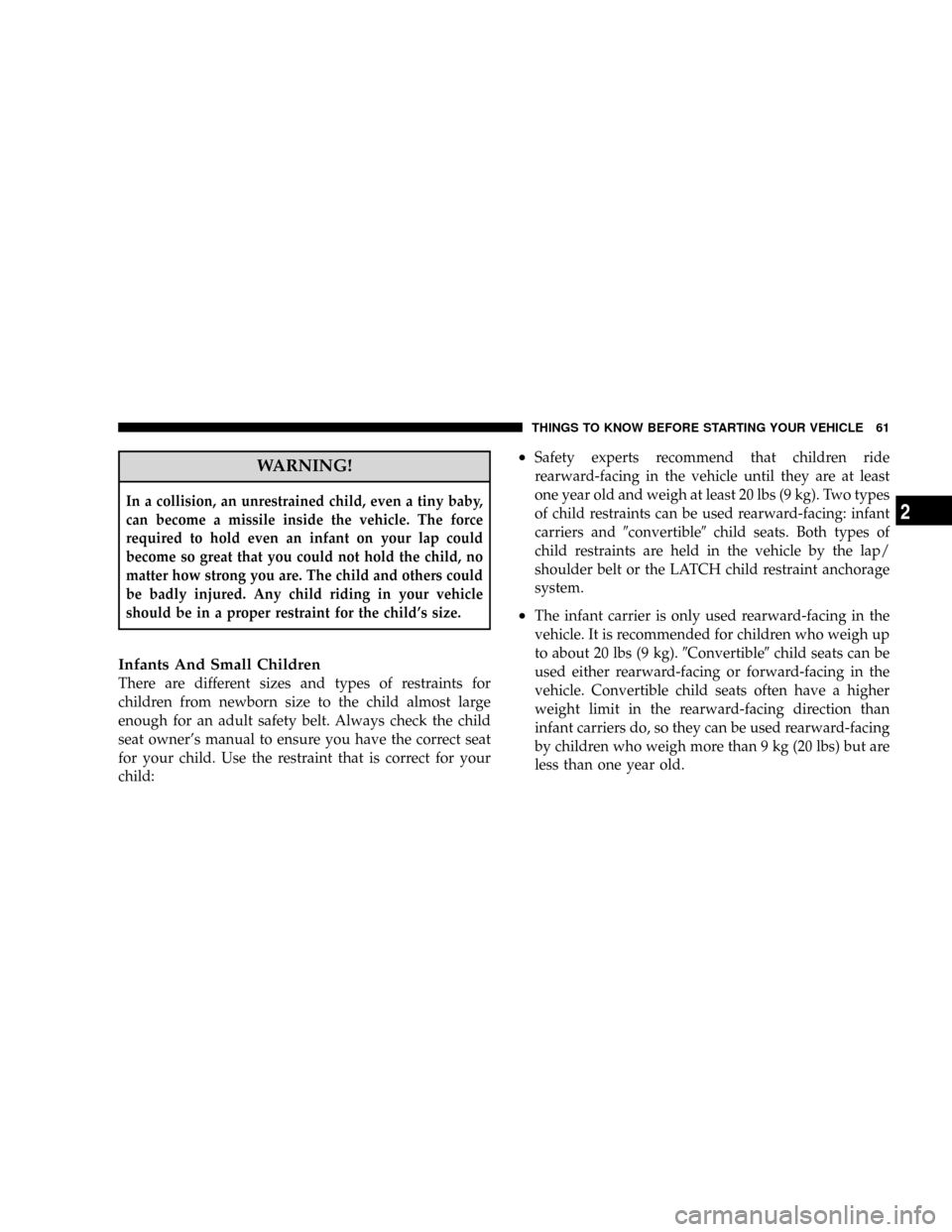
WARNING!
In a collision, an unrestrained child, even a tiny baby,
can become a missile inside the vehicle. The force
required to hold even an infant on your lap could
become so great that you could not hold the child, no
matter how strong you are. The child and others could
be badly injured. Any child riding in your vehicle
should be in a proper restraint for the child's size.
Infants And Small Children
There are different sizes and types of restraints for
children from newborn size to the child almost large
enough for an adult safety belt. Always check the child
seat owner's manual to ensure you have the correct seat
for your child. Use the restraint that is correct for your
child:
²Safety experts recommend that children ride
rearward-facing in the vehicle until they are at least
one year old and weigh at least 20 lbs (9 kg). Two types
of child restraints can be used rearward-facing: infant
carriers and9convertible9child seats. Both types of
child restraints are held in the vehicle by the lap/
shoulder belt or the LATCH child restraint anchorage
system.
²The infant carrier is only used rearward-facing in the
vehicle. It is recommended for children who weigh up
to about 20 lbs (9 kg).9Convertible9child seats can be
used either rearward-facing or forward-facing in the
vehicle. Convertible child seats often have a higher
weight limit in the rearward-facing direction than
infant carriers do, so they can be used rearward-facing
by children who weigh more than 9 kg (20 lbs) but are
less than one year old.
THINGS TO KNOW BEFORE STARTING YOUR VEHICLE 61
2
Page 63 of 440
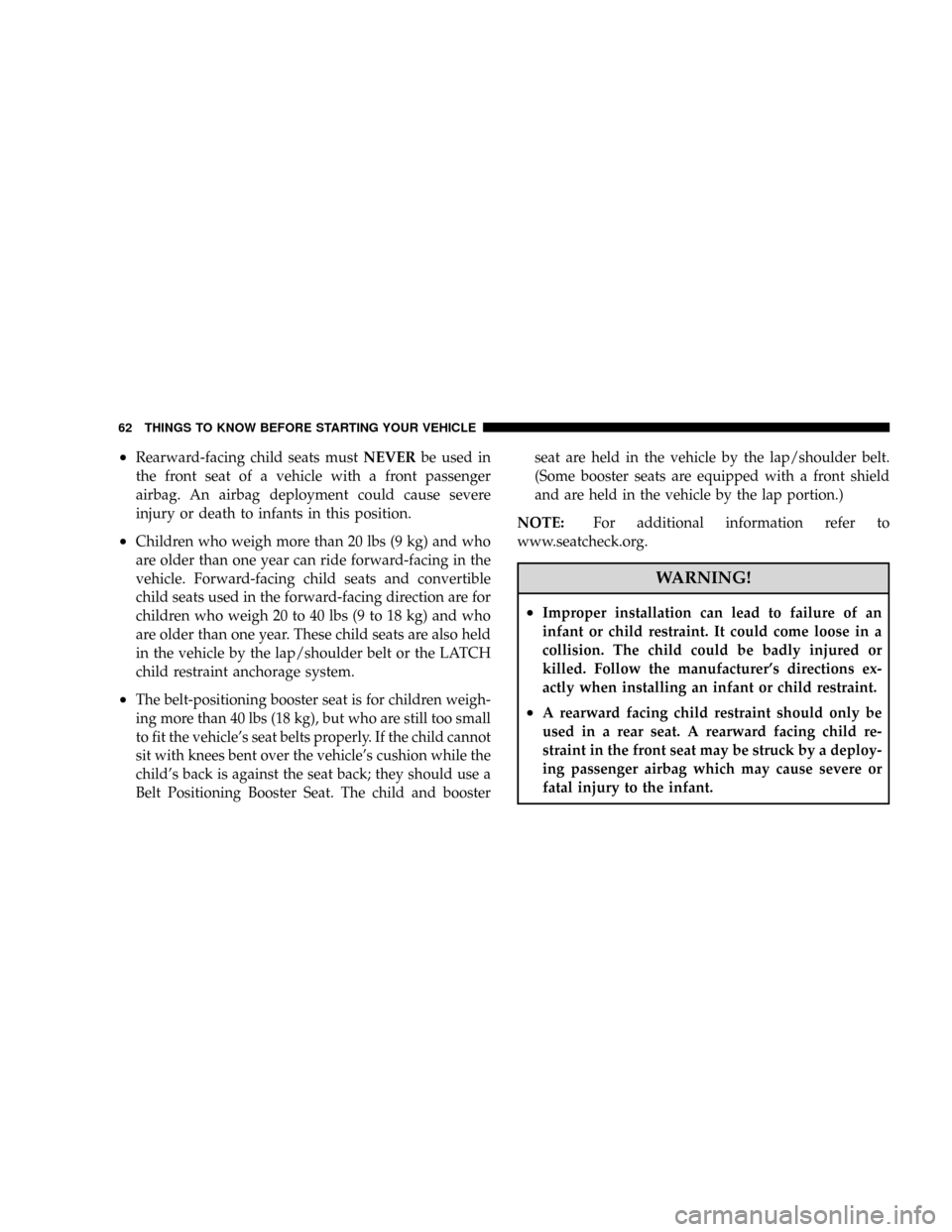
²Rearward-facing child seats mustNEVERbe used in
the front seat of a vehicle with a front passenger
airbag. An airbag deployment could cause severe
injury or death to infants in this position.
²Children who weigh more than 20 lbs (9 kg) and who
are older than one year can ride forward-facing in the
vehicle. Forward-facing child seats and convertible
child seats used in the forward-facing direction are for
children who weigh 20 to 40 lbs (9 to 18 kg) and who
are older than one year. These child seats are also held
in the vehicle by the lap/shoulder belt or the LATCH
child restraint anchorage system.
²The belt-positioning booster seat is for children weigh-
ing more than 40 lbs (18 kg), but who are still too small
to fit the vehicle's seat belts properly. If the child cannot
sit with knees bent over the vehicle's cushion while the
child's back is against the seat back; they should use a
Belt Positioning Booster Seat. The child and boosterseat are held in the vehicle by the lap/shoulder belt.
(Some booster seats are equipped with a front shield
and are held in the vehicle by the lap portion.)
NOTE:For additional information refer to
www.seatcheck.org.
WARNING!
²Improper installation can lead to failure of an
infant or child restraint. It could come loose in a
collision. The child could be badly injured or
killed. Follow the manufacturer's directions ex-
actly when installing an infant or child restraint.
²A rearward facing child restraint should only be
used in a rear seat. A rearward facing child re-
straint in the front seat may be struck by a deploy-
ing passenger airbag which may cause severe or
fatal injury to the infant.
62 THINGS TO KNOW BEFORE STARTING YOUR VEHICLE
Page 64 of 440
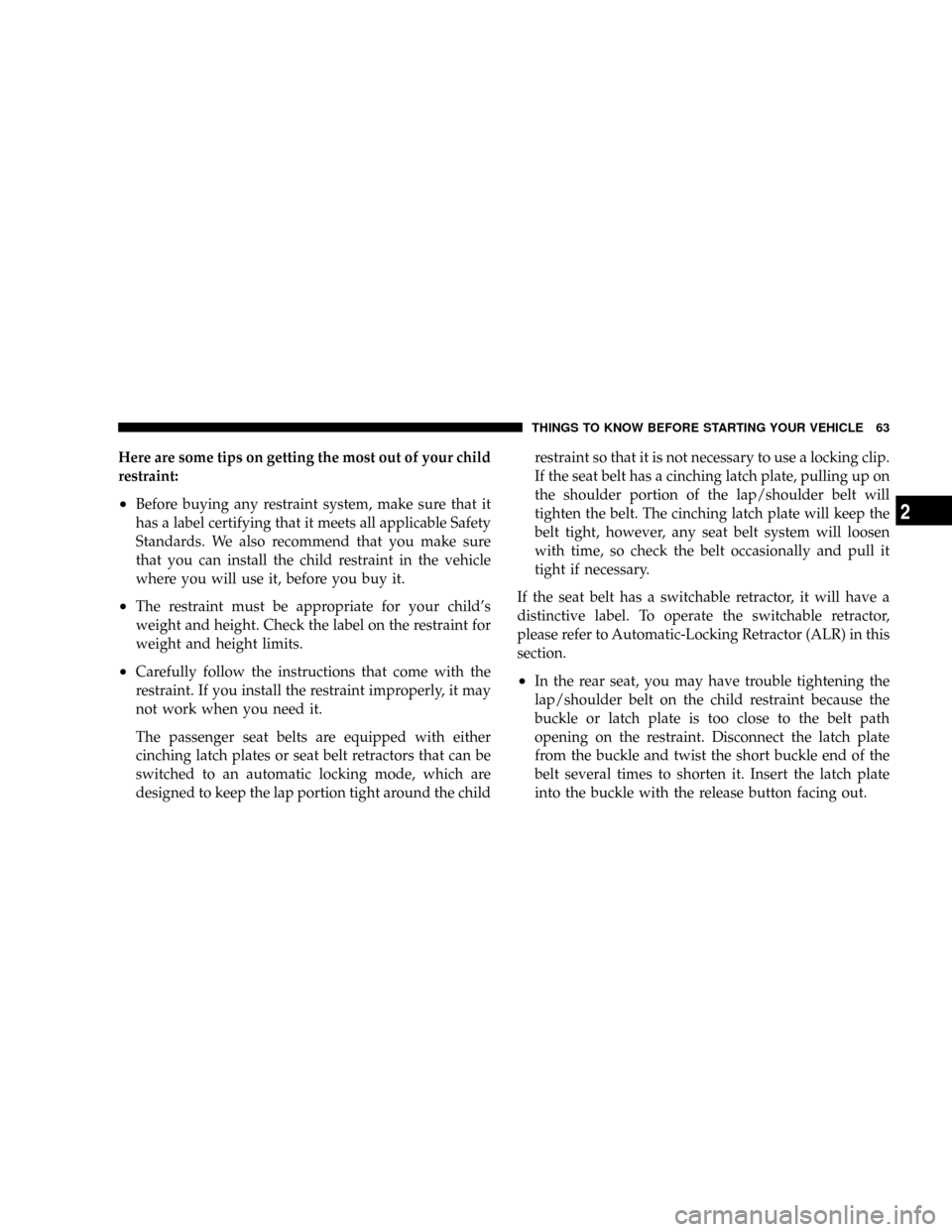
Here are some tips on getting the most out of your child
restraint:
²Before buying any restraint system, make sure that it
has a label certifying that it meets all applicable Safety
Standards. We also recommend that you make sure
that you can install the child restraint in the vehicle
where you will use it, before you buy it.
²The restraint must be appropriate for your child's
weight and height. Check the label on the restraint for
weight and height limits.
²Carefully follow the instructions that come with the
restraint. If you install the restraint improperly, it may
not work when you need it.
The passenger seat belts are equipped with either
cinching latch plates or seat belt retractors that can be
switched to an automatic locking mode, which are
designed to keep the lap portion tight around the childrestraint so that it is not necessary to use a locking clip.
If the seat belt has a cinching latch plate, pulling up on
the shoulder portion of the lap/shoulder belt will
tighten the belt. The cinching latch plate will keep the
belt tight, however, any seat belt system will loosen
with time, so check the belt occasionally and pull it
tight if necessary.
If the seat belt has a switchable retractor, it will have a
distinctive label. To operate the switchable retractor,
please refer to Automatic-Locking Retractor (ALR) in this
section.²In the rear seat, you may have trouble tightening the
lap/shoulder belt on the child restraint because the
buckle or latch plate is too close to the belt path
opening on the restraint. Disconnect the latch plate
from the buckle and twist the short buckle end of the
belt several times to shorten it. Insert the latch plate
into the buckle with the release button facing out.
THINGS TO KNOW BEFORE STARTING YOUR VEHICLE 63
2